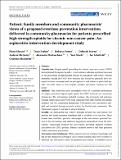Files in this item
Patient, family members and community pharmacists' views of a proposed overdose prevention intervention delivered in community pharmacies for patients prescribed high-strength opioids for chronic non-cancer pain : an explorative intervention development study
Item metadata
| dc.contributor.author | Mercer, Fiona | |
| dc.contributor.author | Parkes, Tessa | |
| dc.contributor.author | Foster, Rebecca | |
| dc.contributor.author | Steven, Deborah | |
| dc.contributor.author | Baldacchino, Alexander Mario | |
| dc.contributor.author | McAuley, Andrew | |
| dc.contributor.author | Steele, Wez | |
| dc.contributor.author | Schofield, Joe | |
| dc.contributor.author | Matheson, Catriona | |
| dc.date.accessioned | 2022-11-07T15:30:10Z | |
| dc.date.available | 2022-11-07T15:30:10Z | |
| dc.date.issued | 2023-03-01 | |
| dc.identifier | 281211365 | |
| dc.identifier | 4c78b571-6338-4c4d-abf8-955ded256d5f | |
| dc.identifier | 36165733 | |
| dc.identifier | 000859961900001 | |
| dc.identifier | 85138990828 | |
| dc.identifier | 36165733 | |
| dc.identifier.citation | Mercer , F , Parkes , T , Foster , R , Steven , D , Baldacchino , A M , McAuley , A , Steele , W , Schofield , J & Matheson , C 2023 , ' Patient, family members and community pharmacists' views of a proposed overdose prevention intervention delivered in community pharmacies for patients prescribed high-strength opioids for chronic non-cancer pain : an explorative intervention development study ' , Drug and Alcohol Review , vol. 42 , no. 3 , pp. 517-526 . https://doi.org/10.1111/dar.13554 | en |
| dc.identifier.issn | 0959-5236 | |
| dc.identifier.other | ORCID: /0000-0002-5388-7376/work/122719873 | |
| dc.identifier.uri | https://hdl.handle.net/10023/26319 | |
| dc.description | Funding: This project was funded/supported by a research bursary from NHS Fife R&D&I department. | en |
| dc.description.abstract | Introduction Despite opioid prescribing for chronic non-cancer pain (CNCP) having limited therapeutic benefits, recent evidence indicates significant increases in the prescribing of high-strength opioids for individuals with CNCP. Patients prescribed opioids for CNCP have overdose risk factors but generally have low opioid overdose awareness and low perceptions of risk related to prescribed opioids. Currently there are few bespoke overdose prevention resources for this group. Methods This qualitative study investigated views on a naloxone intervention for people prescribed high-strength opioids for CNCP delivered via community pharmacies. The intervention included overdose risk awareness and naloxone training and provision. Interviews were conducted with eight patients, four family members, and two community pharmacists. Participants were convenience sampled and recruited through networks within the Scottish pain community. The Framework approach was used to analyse findings. Results All participants had positive attitudes towards the intervention, but patients and family members considered risk of overdose to be very low. Three themes were identified: potential advantages of the intervention; potential barriers to the intervention; and additional suggestions and feedback about the intervention. Advantages included the intervention providing essential overdose information for CNCP patients. Barriers included resource and time pressures within community pharmacies. Discussion and conclusion While patients had low overdose knowledge and did not see themselves as being at risk of opioid overdose, they were receptive to naloxone use and positive about the proposed intervention. A feasibility trial is merited to further investigate how the intervention would be experienced within community pharmacy settings. | |
| dc.format.extent | 10 | |
| dc.format.extent | 894025 | |
| dc.language.iso | eng | |
| dc.relation.ispartof | Drug and Alcohol Review | en |
| dc.subject | Overdose risk | en |
| dc.subject | Prescription opioids | en |
| dc.subject | Chronic non-cancer pain | en |
| dc.subject | Overdose intervention | en |
| dc.subject | Naxolone | en |
| dc.subject | HV Social pathology. Social and public welfare | en |
| dc.subject | RM Therapeutics. Pharmacology | en |
| dc.subject | NDAS | en |
| dc.subject | SDG 3 - Good Health and Well-being | en |
| dc.subject | MCC | en |
| dc.subject.lcc | HV | en |
| dc.subject.lcc | RM | en |
| dc.title | Patient, family members and community pharmacists' views of a proposed overdose prevention intervention delivered in community pharmacies for patients prescribed high-strength opioids for chronic non-cancer pain : an explorative intervention development study | en |
| dc.type | Journal article | en |
| dc.contributor.institution | University of St Andrews. School of Medicine | en |
| dc.contributor.institution | University of St Andrews. Centre for Minorities Research (CMR) | en |
| dc.contributor.institution | University of St Andrews. Population and Behavioural Science Division | en |
| dc.identifier.doi | https://doi.org/10.1111/dar.13554 | |
| dc.description.status | Peer reviewed | en |
This item appears in the following Collection(s)
Items in the St Andrews Research Repository are protected by copyright, with all rights reserved, unless otherwise indicated.

